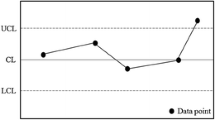Abstract
The non-probabilistic approach to fatigue life analysis was studied using the convex models—interval, ellipsoidal and multi-convex models. The lower and upper bounds of the fatigue life were obtained by using the second-order Taylor series and Lagrange multiplier method. The solving process for derivatives of the implicit life function was presented. Moreover, a median ellipsoidal model was proposed which can take into account the sample blind zone and almost impossibility of concurrence of some small probability events. The Monte Carlo method for multi-convex model was presented, an important alternative when the analytical method does not work. A project example was given. The feasibility and rationality of the presented approach were verified. It is also revealed that the proposed method is conservative compared to the traditional probabilistic method, but it is a useful complement when it is difficult to obtain the accurate probability densities of parameters.
Similar content being viewed by others
References
Yao W X. Fatigue life prediction of structures (in Chinese). Beijing: National Defense Industry Press, 2003
Stephens R I, Fatemi A. Metal Fatigue in Engineering. 2nd ed. New York: John Wiley & Sons, 2001
Chu J Z, Wang J Y. Life quantitative design of combination of multi-disciplines—a present urgent task of mechanical design in China (in Chinese). Chin J Mech Eng, 1998, 9 (11): 1–2
Gao Z T, Xiong J J. Fatigue Reliability (in Chinese). Beijing: Press of Beijing University of Aeronautics and Astronautics, 2000
Chen X, Lind N C. Fast probability integration by three parameter normal trail approximation. Struct Safety, 1983, 1: 269–276
Rackwitz R, Fiessler B. Structural reliability under combined random load sequences. Comput Struct, 1978, 9: 489–494
Wu Y T, Wirsching P H. New algorithm for structural reliability estimation. J Eng Mech, 1987, 9: 1319–1336
Wirsching P H, Torng T Y, Martin W S. Advanced fatigue reliability analysis. Int J Fatigue, 1991, 5: 389–394
Doudard C, Calloch S, Cugy P, et al. A probabilistic two-scale model for high-cycle fatigue life predictions. Fatigue Fracture Eng Mater Struct, 2005, 3: 279–288
Yang Z C, Shen W C, Peng M L. Research on residual life prediction of turbine blade-disc under random environment (in Chinese). J Aerospace power, 2009, 24(8): 1677–1683
Kaminski M. On probabilistic fatigue models for composite materials. Int J Fatigue, 2002, 2–4: 477–495
Guiliano A, Baratta A, Casciati F. Probabilistic methods in structural engineering. London, New York: Chapman & Hall, 1984
Pascual F G, William Q M. Estimating fatigue curves with the random fatigue-limit model. Technometrics, 1999, 4: 277–290
Akpan U O, Rushton P A, Koko S T. Development of a fuzzy probabilistic methodology for multiple-site fatigue damage. J Aircraft, 2004, 3: 633–640
Wang X L. Research on Prediction Method of Fatigue Life with Uncertainty (in Chinese). Dissertation for Doctoral Degree. Nanjing: Nanjing University of Aeronautics and Astronautics, 2009
Liu K D, Wu H Q, Wang N P, et al. Unascertained Mathematics (in Chinese). Wuhan: Press of Huazhong University of Science and Technology, 1997
Ben-Haim Y, Elishakoff I. Convex Models of Uncertainty in Applied Mechanics. Amsterdam: Elsevier Science Publishers, 1990
Ben-Haim Y. A non-probabilistic concept of reliability. Struct Safety, 1994, 4: 227–245
Ben-Haim Y. Fatigue lifetime with load uncertainty represented by convex model. J Eng Mech, 1994, 3: 445–462
Qiu Z P, Wang X J. Interval estimation for structural fatigue lifetime (in Chinese). Chin J Theor Appl Mech, 2005, 37 (5): 653–657
Zhou J. Non-probabilistic Design Optimization with Insufficient Data Using Possibility and Evidence Theories. Oakland: Oakland University Press, 2007
Sun W C, Yang Z C, Huang L. Application of structural non-proba-bilistic reliability model in fracture mechanics analysis (in Chinese). J Basic Sci Eng, 2010, 18 (5): 816–822
Qiu Z P, Wang X J, Ma Z B. A set-theoretical model for estimation of structural fatigue lifetime (in Chinese). Acta Mech Solida Sin, 2006, 27(1): 91–97
Sun W C, Yang Z C. Fatigue lifetime assessment based on probabilistic and non-probabilistic mixed model. In: proceedings of International Conference on Mechanical and Electrical Technology-2010. New York: IEEE, 2010. 413–416
Sun W C, Yang Z C. Fatigue remainder life analysis of cracked pressure vessels based on mixed variables (in Chinese). Chin J Pressure Vessel Tech, 2010, 27(1): 17–20
Qiu Z P, Lin Q, Wang X J. Convex models and probabilistic approach of nonlinear fatigue failure. Chaos Solitions Fractals, 2008, 1: 129–137
Xue H X, Tang W Y, Zhang S K, et al. Interval analysis method of fatigue and fracture reliability for offshore structures based on probabilistic and non-probabilistic hybrid model. In: Proceedings of the Sixteenth International Offshore and Polar Engineering Conference-2006. USA: The International Society of Offshore and Polar Engineers, 2006
Yang Z C, Ni N, Yang Y, et al. Turbo Machinery (in Chinese). Beijing: National Defense Industry Press, 2007. 253–262
Shen W C. Research on Residual Life Prediction of Turbine Blade-Disc Based on Stochastic Finite Element (in Chinese). Dissertation for Master’s Degree. Wuhan: Naval University of Engineering, 2008
Author information
Authors and Affiliations
Corresponding author
Rights and permissions
About this article
Cite this article
Sun, W., Yang, Z. & Li, K. Non-deterministic fatigue life analysis using convex set models. Sci. China Phys. Mech. Astron. 56, 765–774 (2013). https://doi.org/10.1007/s11433-013-5023-7
Received:
Accepted:
Published:
Issue Date:
DOI: https://doi.org/10.1007/s11433-013-5023-7




